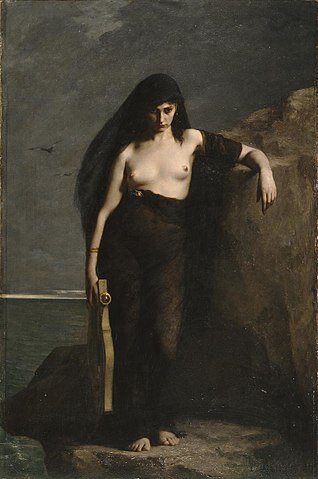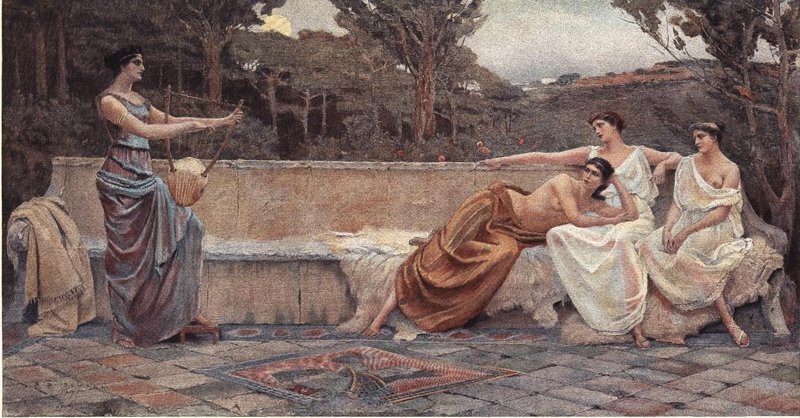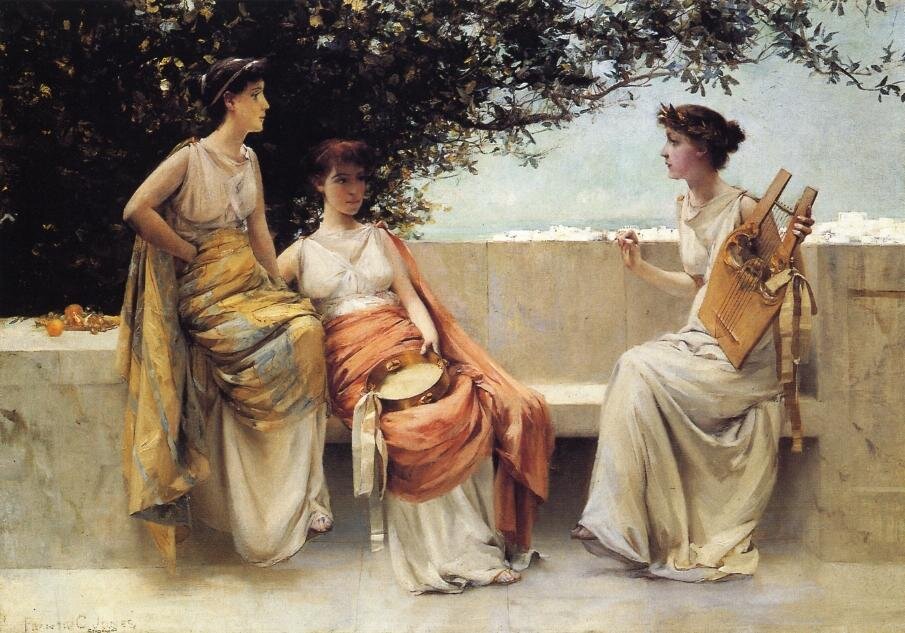27. Sappho: F*cking Superb, You Funky Little Lesbian
/At long last, hosts Gretchen and Leigh are going back to the beginning, to the OG lesbian: Sappho herself. Despite the dearth of information about her life and history, your hosts still find plenty to say about Sappho, her poetry, her legacy, and all the debate that’s circled around her for years. Was she a ‘school mistress’? Was she actually a man? Did she really have a husband or throw herself from a cliff? Find out what Leigh and Gretchen think and listen to fragmentary poetry filled with queer longing and other relatable feels like fire burning beneath flesh, wind crashing through mountain oaks, and…celery.
We’ll start off with one of the poems we didn’t discuss in the episode, but is a piece of writing that forms the basis for why we do this show. As Sappho writes in Fragment 147,
someone will remember us
I say
even in another time
A Closer Look at Sappho
Painting of Sappho by the “Sappho Painter” (circaa 510 BCE).
Sappho depicted holding a plectrum and lyre on the side of a vase (circa 470 BCE).
Head of a female figure widely believed to be a copy of the 4th Century BCE portrait of Sappho by Silanion.
Roman scupture of Sappho (5th Century BCE). Inscription reads “Sappho of Eresos.”
“woman with Wax Tablets and Stylus,” a Fresco from Pompeii (circa 55-79 CE). IT is frequently called “Sappho,” though we have no idea if the artist meant it as a portrait of the poet or not.
Fragment 58 (tithonus poem). Unfortunately, this is what a lot of Sappho’s poetry looks like, though usually even worse for the wear. :(
Woodcut of Sappho from Giovanni Boccaccio's De mulieribus claris (circa 1541).
Sappho and Erinna in a Garden at Mytilene by Simeon Solomon (1864).
Sappho, by Charles Mengin (1877).
Sappho by Amanda brewster Sewell (1891).
Sappho by Francis Coates Jones (1895).
Sappho of Lesbos by John William Godward (1904).
The Sapphic Stanza
Sappho not only wrote beautiful, haunting poems, but invented an entirely unique poetic form, appropriately named after her! Composed of two hendecasyllabic (eleven syllables) verses, and then a third verse beginning the same way and continuing with five more syllables (sometimes written as a fourth line), it gave Sappho’s poetry its lyrical nature.
Using "–" for a long syllable, "∪" for a short syllable, and "x" for a free syllable, the meter looked like this:
– ∪ – x – ∪ ∪ – ∪ – –
– ∪ – x – ∪ ∪ – ∪ – –
– ∪ – x – ∪ ∪ – ∪ – –
– ∪ ∪ – –
The Mixolydian Mode
This link also has some great information about another invention of Sappho’s: the Mixolydian Mode, which is a musical scale that is still in use today, although heavily altered through history!
What did Sappho’s poetry sound like?
Sappho’s poetry was meant to be recited to the sound of an ancient Greek instrument called a lyre, sometimes made from tortoise-shell, and looked like this:
She references the instrument in her poetry often, like in this fragment:
I took my lyre and said:
Come now, my heavenly
tortoise shell: become
a speaking instrument
And in the below video, you can see a modern replica of an ancient Greek tortoise-shell lyre, and hear what it would have sounded like, also being plucked and strummed with a plectrum, the picking instrument also credited as an invention of Sappho’s! A musical genius! The person in the video is Michael Levy, a musician who records and interprets ancient Greek lyre music:
Here’s a video of someone’s recorded interpretation of a Sapphic wedding hymn:
And here’s some more of Michael Levy’s music, with several different hymns and songs on lyre:
As a special bonus, two of our amazing listeners created a Sappho poetry generator you can play around with, as referenced in this episode!
Check it out here!
If you want to learn more about the Sappho, check out our full list of sources and further reading below!
Online Articles:
Books and Print Articles:
Sapphistries: A Global History of Love Between Women by Leila J. Rupp
Who’s Who in Gay & Lesbian History ed by Robert Aldrich and Garry Wotherspoon
The Lesbian Lyre: Reclaiming Sappho for the 21st Century by Jeffrey M. Duban
Lesbian Desire in the Lyrics of Sappho by Jane McIntosh Snyder
Early Greek Poets' Lives: The Shaping of the Tradition by Maarit Kivilo (Sappho chapter)
Ten Poems of Sappho: Provenance, Authenticity, and Text of the New Sappho Papyri
Sappho and her Social Context: Sense and Sensuality by Judith P. Hallett
Translations of Sappho’s Poetry Used in this Episode:
Sappho: A New Translation translated by Mary Barnard
If Not, Winter: Fragments of Sappho translated by Anne Carson
Sappho: A New Translation of the Complete Works translated by Diane Rayor















